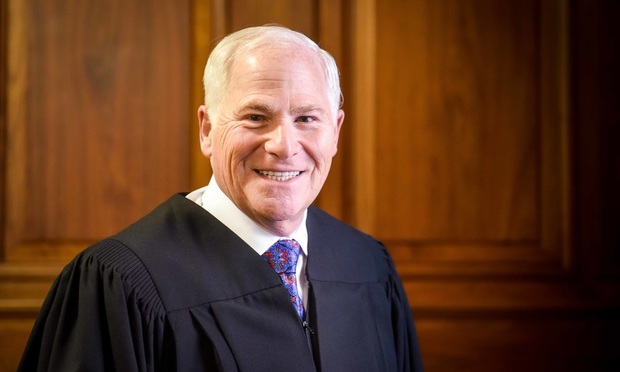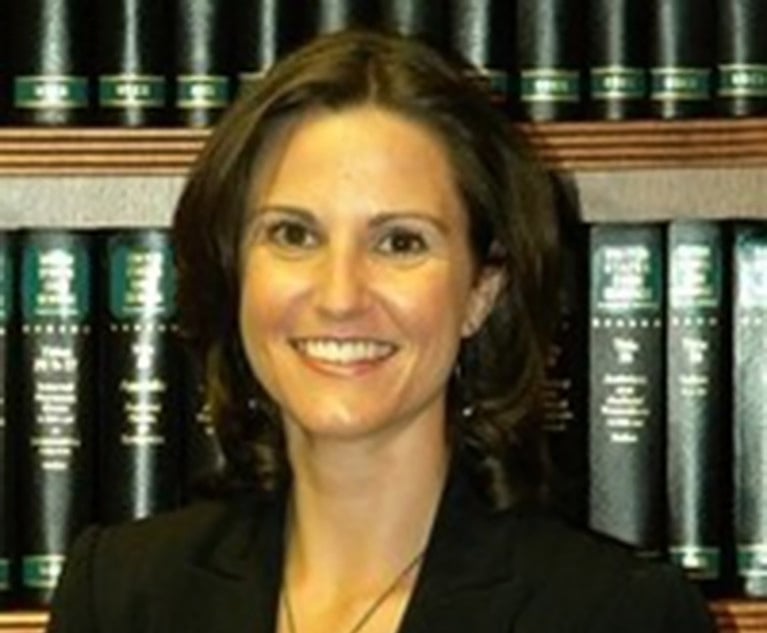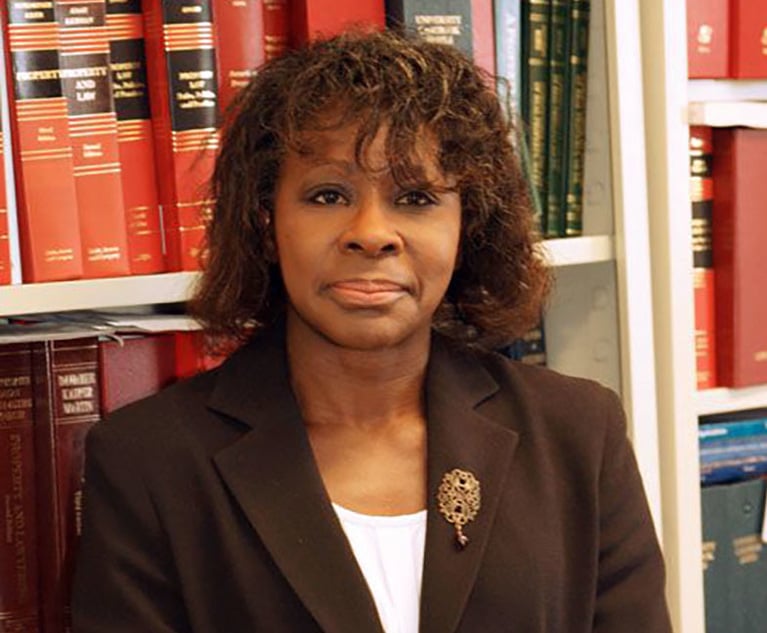Constitutional Change Will Advance Appellate Reform
Alan Scheinkman, Presiding Justice of the Appellate Division, Second Department, examines the explosive growth of the Department and opportunities for reform that could help alleviate its large caseload.
January 24, 2020 at 01:12 PM
7 minute read
 Justice Alan Scheinkman
Justice Alan Scheinkman
New York's court system, with its 11 separate constitutionally enshrined trial-level courts, is unquestionably the most fragmented and complicated court system in our nation and, perhaps, even in the world. No one sitting down today to devise a judicial branch of government could have come up with it. It is the product of centuries of historical accident and was last addressed in 1962, when, in a major achievement, the number of trial courts was reduced to the present 11 through the elimination of many trial courts at the time, coupled with the establishment of the Family Court and the New York City Civil and Criminal Courts. Most judges and lawyers, the business community at large, and those whose lives and well-being have been at stake while attempting to navigate the way through our complex courts, have long recognized that there surely must be a better way to effectively and efficiently provide justice to all New Yorkers. Chief Judge Janet DiFiore has proposed a comprehensive plan for consolidating the state's courts into a three-tier trial court structure, a plan that would also lead to significant reform of the Appellate Division.
Under the Chief Judge's proposed constitutional amendment, the courts of original jurisdiction would consist of the Supreme Court, a statewide Municipal Court, and the existing Town and Village Courts. The Court of Claims, the County Courts, the Family Courts, and the Surrogate's Courts would be abolished, their jurisdiction would be acquired by the Supreme Court, and the judges of those courts would become Supreme Court Justices. The Supreme Court would consist of six divisions: Family, Probate, Criminal, State Claims, Commercial, and General. The New York City Civil and Criminal Courts, the District Courts on Long Island, and the 61 City Courts outside New York City would be abolished, and the judges of those courts would become judges of the Municipal Court. The plan includes a merger-in-place provision, under which judges who are transferred to the Supreme Court and the Municipal Court, as well as their successors in office, would be elected or appointed in the same manner as they had been in their now-abolished positions. In addition, the Legislature would be authorized to change the number of Appellate Division Judicial Departments once every 10 years.
The Chief Judge's proposal would have significant implications for the Appellate Division and, in particular, the Second Judicial Department. The state was divided into the four existing departments in 1896. The departments were originally balanced, with each containing roughly 25% of the state's population. Over the ensuing 125 years, the Second Department has grown to where it is the home for more than 50% of the state's population. The explosive growth in the Second Department's caseload led to the transfer of hundreds of cases to other Departments in the 1980s. That expedient, which was embraced by almost no one, succeeded for a while. But within a few years, the number of civil appeals again outpaced the court's ability to hear them, with the result that, while the other Departments have been current in their dockets, the Second Department once again became mired with a substantial civil appeals backlog. Considering the appeals waiting to be heard, the Second Department has before it roughly approximately 65% of the state's Appellate Division caseload, while the other three departments collectively handle the remaining 35%. While the court continues to innovate and makes every effort to reduce what can be a lengthy wait for appellate justice, it has long been evident that structural reform is necessary to provide a long-term permanent solution.
The Second Department has a constitutionally authorized complement of seven justices, including the presiding justice. As the workload increased, increasing use has been made of "additional" justices, whose appointment is permitted to help with calendar conditions. Our court now has 15 such positions—more than double the number of judgeships authorized by the Constitution. The beautiful 1930s courthouse at 45 Monroe Place simply cannot house the court and its staff. Adding more and more "additional" judges will no longer be an option when we have just about exhausted every nook and cranny at both 45 Monroe Place and our overflow space at 1 Pierrepont Plaza.
The Chief Judge's court reform plan offers a pathway to change: Once every 10 years, the Legislature would be authorized to increase or decrease the number of judicial departments. The creation of a Fifth Judicial Department pursuant to this provision would help to balance the caseload among the departments. While the Legislature has the existing authority to change Departmental boundaries every 10 years, that authority has not been invoked because of disagreements as to what counties from the Second Department would move into either the First or Third Departments, which are the geographically proximate departments. Creation of a new Department should be more practicably achievable. Although the establishment of a new Department would require new facilities, so too does keeping the Second Department as it is since the court is basically out of space.
Simply splitting the present Second Department in two is not by itself a solution since, if that were the extent of the change, all we would be doing is moving some judges to another building. What is needed is more appellate judges. For this to happen, the pool from which these judges would be drawn must be enlarged. For every Supreme Court Justice appointed to the Appellate Division, there is one less Justice available to handle the ever-growing trial court calendar. Assuming an equal division of the caseload between a new Second and a new Fifth Department, each of those Departments would likely need between 15 to 20 judges (bearing in mind that each would have a caseload roughly comparable to the present First Department). Simply adding a new Supreme Court judgeship to offset each appellate appointment would cost approximately $1 million per judgeship per year, for a price tag of between $8 to $13 million annually. With the present constitution limiting the number of Supreme Court judgeships in the judicial districts, it would be possible at present to add only one additional judgeship in Kings County, meaning that one of our populous counties will become locked out of new Supreme Court seat possibilities. These fiscal and constitutional limitations would be avoided through the trial court consolidation aspect of the Chief Judge's proposal.
By substantially expanding the number of Justices of the Supreme Court through the absorption of the Court of Claims, Surrogate's Court, Family Court and County Court, the proposal would concomitantly expand the pool of Justices from which the Governor would select Justices of the Appellate Division. Since these trial court judgeships already exist, the fiscal consequences would be minimal. Selecting appellate judges from these courts would minimize the loss to the trial bench since, with the merger of the courts, the trial court losses could be readily absorbed without complicated back-fill plans. The proposal would have the advantage of increasing diversity in terms of the kinds of recent trial experience those appellate judges will have had. Justices appointed to the Appellate Division would now include those with current expertise in areas such as family law, probate law, and, outside the City of New York, criminal law (since the County Courts handle most major criminal cases outside the City). The creation of additional Appellate Division slots will also create more opportunities for all Supreme Court Justices to seek appointments to the Appellate Division.
The Chief Judge's proposal, while focused on long-overdue trial court reform, offers the prospect of significant and vitally needed appellate court reform as well. With the opening of the new legislative session this month, the proposal deserves careful consideration by both the Assembly and the Senate and the support of those who think that it is past the time when New York should have a modern court system.
This content has been archived. It is available through our partners, LexisNexis® and Bloomberg Law.
To view this content, please continue to their sites.
Not a Lexis Subscriber?
Subscribe Now
Not a Bloomberg Law Subscriber?
Subscribe Now
NOT FOR REPRINT
© 2025 ALM Global, LLC, All Rights Reserved. Request academic re-use from www.copyright.com. All other uses, submit a request to [email protected]. For more information visit Asset & Logo Licensing.
You Might Like
View All


Trending Stories
- 1Thursday Newspaper
- 2Public Notices/Calendars
- 3Judicial Ethics Opinion 24-117
- 4Rejuvenation of a Sharp Employer Non-Compete Tool: Delaware Supreme Court Reinvigorates the Employee Choice Doctrine
- 5Mastering Litigation in New York’s Commercial Division Part V, Leave It to the Experts: Expert Discovery in the New York Commercial Division
Who Got The Work
J. Brugh Lower of Gibbons has entered an appearance for industrial equipment supplier Devco Corporation in a pending trademark infringement lawsuit. The suit, accusing the defendant of selling knock-off Graco products, was filed Dec. 18 in New Jersey District Court by Rivkin Radler on behalf of Graco Inc. and Graco Minnesota. The case, assigned to U.S. District Judge Zahid N. Quraishi, is 3:24-cv-11294, Graco Inc. et al v. Devco Corporation.
Who Got The Work
Rebecca Maller-Stein and Kent A. Yalowitz of Arnold & Porter Kaye Scholer have entered their appearances for Hanaco Venture Capital and its executives, Lior Prosor and David Frankel, in a pending securities lawsuit. The action, filed on Dec. 24 in New York Southern District Court by Zell, Aron & Co. on behalf of Goldeneye Advisors, accuses the defendants of negligently and fraudulently managing the plaintiff's $1 million investment. The case, assigned to U.S. District Judge Vernon S. Broderick, is 1:24-cv-09918, Goldeneye Advisors, LLC v. Hanaco Venture Capital, Ltd. et al.
Who Got The Work
Attorneys from A&O Shearman has stepped in as defense counsel for Toronto-Dominion Bank and other defendants in a pending securities class action. The suit, filed Dec. 11 in New York Southern District Court by Bleichmar Fonti & Auld, accuses the defendants of concealing the bank's 'pervasive' deficiencies in regards to its compliance with the Bank Secrecy Act and the quality of its anti-money laundering controls. The case, assigned to U.S. District Judge Arun Subramanian, is 1:24-cv-09445, Gonzalez v. The Toronto-Dominion Bank et al.
Who Got The Work
Crown Castle International, a Pennsylvania company providing shared communications infrastructure, has turned to Luke D. Wolf of Gordon Rees Scully Mansukhani to fend off a pending breach-of-contract lawsuit. The court action, filed Nov. 25 in Michigan Eastern District Court by Hooper Hathaway PC on behalf of The Town Residences LLC, accuses Crown Castle of failing to transfer approximately $30,000 in utility payments from T-Mobile in breach of a roof-top lease and assignment agreement. The case, assigned to U.S. District Judge Susan K. Declercq, is 2:24-cv-13131, The Town Residences LLC v. T-Mobile US, Inc. et al.
Who Got The Work
Wilfred P. Coronato and Daniel M. Schwartz of McCarter & English have stepped in as defense counsel to Electrolux Home Products Inc. in a pending product liability lawsuit. The court action, filed Nov. 26 in New York Eastern District Court by Poulos Lopiccolo PC and Nagel Rice LLP on behalf of David Stern, alleges that the defendant's refrigerators’ drawers and shelving repeatedly break and fall apart within months after purchase. The case, assigned to U.S. District Judge Joan M. Azrack, is 2:24-cv-08204, Stern v. Electrolux Home Products, Inc.
Featured Firms
Law Offices of Gary Martin Hays & Associates, P.C.
(470) 294-1674
Law Offices of Mark E. Salomone
(857) 444-6468
Smith & Hassler
(713) 739-1250







